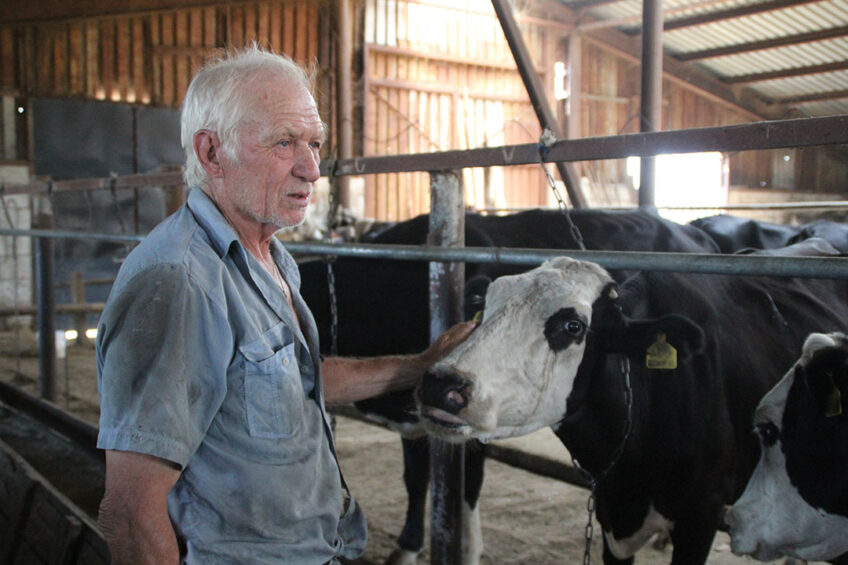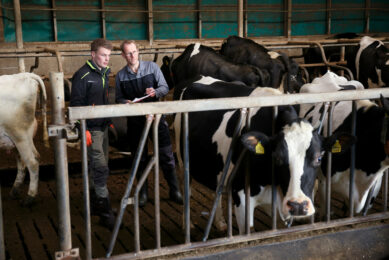Russia’s strategy to tackle mastitis and antibiotics

Russia is looking for new ways to deal with mastitis as the country is increasingly looking to curb veterinarians’ use of antibiotics. It is also looking into designing novel types of bacteriophages.
It is commonly believed that clinical and subclinical mastitis in Russia is causing more problems than in the European Union (EU), affecting more cows and causing bigger losses. According to Ian Humphery-Smith, the head of private sector investment in Skolkovo RusInnovations, the 2 main problems of the Russian dairy herd are:
- Unusually high rates of clinical and subclinical mastitis
- Unusually low conception rates.
Some evidence exists to suggest that up to 20% of young heifers are already infected with mastitis-causing bacteria before actually entering the milking herd…

Alarmingly high levels of mastitis
Without serious measures, the Russian dairy industry will continue to suffer from alarmingly high levels of mastitis infection and most probably poor conception rates in most of the herd, Humphery-Smith warned in an article published in Russia.
“Some evidence exists to suggest that up to 20% of young heifers are already infected with mastitis-causing bacteria before actually entering the milking herd, but this alone is far from the principal cause of endemic mastitis infection. It is noteworthy that in many Russian milking herds, the bulk of first lactation animals are succumbing to clinical or subclinical infection within 12 months. The negative impact of this level of infection on profitability across the industry is horrendous,” he adds.
Mastitis remains a top enemy of Russian dairy farmers and frequently interferes in the production process, according to the Russian union of dairy producers Soyuzmoloko.
“The mastitis issue is pressing for all types of farms, both for industrial companies and small farmers. Currently, there is no statistical data on mastitis presence in the Russian dairy herd population,” says Maria Zhebit, head of Soyuzmoloko public communication department.
“The spread of mastitis impairs cow fertility and herd productivity, negatively impacting the financial performance of farms and industry as a whole,” Zhebit adds. “Besides, with a systemic problem, expensive imported livestock at modern enterprises have to be culled [due to mastitis].”
The mastitis issue is pressing for all types of farms, both for industrial companies and small farmers.
Mastitis spurs demand for antibiotics
With mastitis presenting widely in the Russian dairy herd, Russian farmers require more antibiotics to handle this problem. This factor is likely to contribute to the problem of excessive use of in-feed antibiotics in the Russian livestock industry, where the veterinary system is such that farmers are free to use antibiotics as they please while growing animals.
They only need to make sure that the animal has no antibiotics in its body when livestock production is obtained. According to Lyubov Savkina, commercial director of the Russian Feedlot agency, Russian companies can use in-feed antibiotics in virtually unlimited quantities.
“The main objective is that the residues of these substances should not be found in the finished products. Unfortunately, this approach significantly differs from the goals of the global campaign aimed at abandoning these drugs,” she says.

Milk from cows with mastitis can not be used
In Russia, milk processors are prohibited from using milk from cows with mastitis, as stated in the regulation on milk and dairy product safety. As Zhebit explains, this regulation sets requirements for the maximum allowable content of somatic cells in milk, with stringent limits set for milk used for baby food production.
“Raw materials from cows with mastitis cannot be processed due to the high content of somatic cells. During the long-term treatment of mastitis with antibiotics, cow’s milk also does not go into processing and does not go to feed the calves, which means it has to be disposed [of], which also affects the financial stability of the sector,” Zhebit adds.
Russia lacks high quality milk
Russia is experiencing a major shortage of high-quality milk, Sergey Kalashnikov, deputy chairman of State Duma’s economic committee, claimed during a press conference in Moscow in December of 2020. Read more…
System monitoring is flawed
Veterinary control in the Russian dairy industry is not perfect, which means that when it comes to mastitis, not everything happens according to the letter of the law, Russian newspaper AiF reports.
According to Vadim Smirnov, deputy director of the Russian veterinary body Rosselkhoznadzor in Kaliningrad Oblast, there are a growing number of cases where antibiotics are found in milk production. Quite often, these cases are associated with backyard farms.
“A peasant gives [antibiotic] injection against mastitis to a cow and does not wait until the drug is out of the body, then sells milk from the animal,” Smirnov says, adding that some backyard farmers in Russia add antibiotics directly to milk from a cow that they know was suffering from mastitis.
The pretend fight against in-feed antibiotics
Russia, Belarus and Kazakhstan declared a common goal to combat antibiotic resistance and to curb the use of in-feed antibiotics, and yet no real steps in that direction have been made so far. Preventive use of antimicrobial drugs are still allowed in these countries with no significant limitations. Read more…
“People [farmers] do not want to lose profit,” says Rustav Aliev, director of a Kaliningrad milk processing plant, adding that his company could discover milk with antibiotics up to 15 times in a single month. “This is a real mess.”
A test for mastitis in Russia costs around RUB55 ($ 0.9) per cow, and backyard farmers prefer to check only 1 in 5 cows. In theory, milk processors should ban unscrupulous suppliers that sell them milk with increased somatic cell content or antibiotics. However, amid a shortage of raw milk in Russia, this does not happen.

According to AiF, milk processors are not letting go of their suppliers because they want to protect their raw materials base. Besides, medium-sized farmers also have quality problems when selling their milk to processing plants. Market participants believe the veterinary control in the industry should be strengthened to improve the situation.
Bacteriophages might be an answer
There is a chance that mastitis in Russia could be handled with new drugs containing bacteriophages – a group of viruses that infect and replicate only in bacterial cells, Russian news service Dairy News reports, citing local scientists.
Since World War II, the rapid spread of antibiotics has killed global interest in bacteriophages, but recently it has risen again in response to expanding antibiotic resistance. Russia has good potential to design some novel bacteriophage products, since this class of viruses was studied in the Soviet Union more than in any Western country, the scientists say.
The use of bacteriophages could contribute to significantly improving the mastitis issue in Russia by 2025, Russian scientists forecast in 2015. However, so far, there has been no noticeable progress in this field.
Just recently, Russia’s first biological resource centre of bacteriophages research has been created. The centre has collected a database of 10,000 microorganisms that will be used to develop novel types of bacteriophage-based drugs in the next 5–7 years. These could be adapted for different organisms and different bacteria strains and so would be highly effective. Some new drugs are also promised for veterinary medicine. With this, bacteriophages have been included in Russia’s strategy to tackle antibiotic resistance by 2030.
Join 13,000+ subscribers
Subscribe to our newsletter to stay updated about all the need-to-know content in the dairy sector, two times a week.










